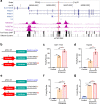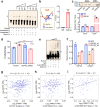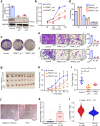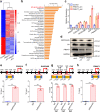An enhancer variant at 16q22.1 predisposes to hepatocellular carcinoma via regulating PRMT7 expression
- PMID: 35264579
- PMCID: PMC8907293
- DOI: 10.1038/s41467-022-28861-0
An enhancer variant at 16q22.1 predisposes to hepatocellular carcinoma via regulating PRMT7 expression
Abstract
Most cancer causal variants are found in gene regulatory elements, e.g., enhancers. However, enhancer variants predisposing to hepatocellular carcinoma (HCC) remain unreported. Here we conduct a genome-wide survey of HCC-susceptible enhancer variants through a three-stage association study in 11,958 individuals and identify rs73613962 (T > G) within the intronic region of PRMT7 at 16q22.1 as a susceptibility locus of HCC (OR = 1.41, P = 6.02 × 10-10). An enhancer dual-luciferase assay indicates that the rs73613962-harboring region has allele-specific enhancer activity. CRISPR-Cas9/dCas9 experiments further support the enhancer activity of this region to regulate PRMT7 expression. Mechanistically, transcription factor HNF4A binds to this enhancer region, with preference to the risk allele G, to promote PRMT7 expression. PRMT7 upregulation contributes to in vitro, in vivo, and clinical HCC-associated phenotypes, possibly by affecting the p53 signaling pathway. This concept of HCC pathogenesis may open a promising window for HCC prevention/treatment.
© 2022. The Author(s).
Conflict of interest statement
The authors declare no competing interests.
Figures







Similar articles
-
Hepatocellular carcinoma risk variant modulates lncRNA HLA-DQB1-AS1 expression via a long-range enhancer-promoter interaction.Carcinogenesis. 2021 Nov 12;42(11):1347-1356. doi: 10.1093/carcin/bgab095. Carcinogenesis. 2021. PMID: 34665859
-
The genetic polymorphism down-regulating HLA-DRB1 enhancer activity facilitates HBV persistence, evolution and hepatocarcinogenesis in the Chinese Han population.J Viral Hepat. 2020 Nov;27(11):1150-1161. doi: 10.1111/jvh.13353. Epub 2020 Jul 7. J Viral Hepat. 2020. PMID: 32568442
-
Genome-wide DNA methylation and hydroxymethylation analysis reveal human menstrual blood-derived stem cells inhibit hepatocellular carcinoma growth through oncogenic pathway suppression via regulating 5-hmC in enhancer elements.Stem Cell Res Ther. 2019 May 31;10(1):151. doi: 10.1186/s13287-019-1243-8. Stem Cell Res Ther. 2019. PMID: 31151404 Free PMC article.
-
Multiple Functional Variants at 13q14 Risk Locus for Osteoporosis Regulate RANKL Expression Through Long-Range Super-Enhancer.J Bone Miner Res. 2018 Jul;33(7):1335-1346. doi: 10.1002/jbmr.3419. Epub 2018 May 17. J Bone Miner Res. 2018. PMID: 29528523
-
Integrated functional genomics-identified LYRM4 promotes fumarate accumulation and hepatocellular carcinoma progression.Arch Biochem Biophys. 2025 Aug;770:110448. doi: 10.1016/j.abb.2025.110448. Epub 2025 May 2. Arch Biochem Biophys. 2025. PMID: 40320061
Cited by
-
Arginine methylation modification in the malignant progression of benign and malignant liver diseases.ILIVER. 2024 Sep 30;3(4):100124. doi: 10.1016/j.iliver.2024.100124. eCollection 2024 Dec. ILIVER. 2024. PMID: 40635858 Free PMC article. Review.
-
The role of hepatocyte nuclear factor 4α (HNF4α) in tumorigenesis.Front Oncol. 2022 Sep 28;12:1011230. doi: 10.3389/fonc.2022.1011230. eCollection 2022. Front Oncol. 2022. PMID: 36249028 Free PMC article. Review.
-
PRMT7 Inhibits the Proliferation and Migration of Gastric Cancer Cells by Suppressing the PI3K/AKT Pathway via PTEN.J Cancer. 2023 Sep 4;14(15):2833-2844. doi: 10.7150/jca.88102. eCollection 2023. J Cancer. 2023. PMID: 37781082 Free PMC article.
-
An inherited predisposition allele promotes gastric cancer via enhancing deubiquitination-mediated activation of epithelial-to-mesenchymal transition signaling.J Clin Invest. 2025 Feb 25;135(8):e179617. doi: 10.1172/JCI179617. eCollection 2025 Apr 15. J Clin Invest. 2025. PMID: 39998882 Free PMC article.
-
An oncogenic enhancer promotes melanoma progression via regulating ETV4 expression.J Transl Med. 2024 Jun 7;22(1):547. doi: 10.1186/s12967-024-05356-8. J Transl Med. 2024. PMID: 38849954 Free PMC article.
References
-
- Bray F, et al. Global cancer statistics 2018: GLOBOCAN estimates of incidence and mortality worldwide for 36 cancers in 185 countries. CA Cancer J. Clin. 2018;68:394–424. - PubMed
-
- Montalto G, et al. Epidemiology, risk factors, and natural history of hepatocellular carcinoma. Ann. N. Y Acad. Sci. 2002;963:13–20. - PubMed
-
- Zhang H, et al. Genome-wide association study identifies 1p36.22 as a new susceptibility locus for hepatocellular carcinoma in chronic hepatitis B virus carriers. Nat. Genet. 2010;42:755–758. - PubMed
Publication types
MeSH terms
Substances
LinkOut - more resources
Full Text Sources
Medical
Molecular Biology Databases
Research Materials
Miscellaneous

